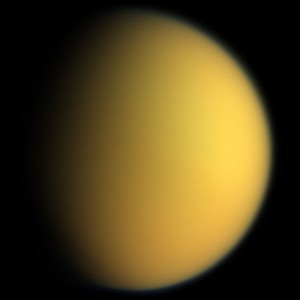
This natural color composite was taken during the Cassini spacecraft’s April 16, 2005, flyby of Titan. From http://en.wikipedia.org/wiki/Titan_%28moon%29.
Interesting public talk to the National Capital Astronomers‘ monthly meeting from Prof. Doug Hamilton of UMD Astronomy.
Prof. Hamilton talked about the origin of Saturn’s moon Titan, an unusual satellite in several ways. Titan has a massive nitrogen and methane atmosphere, full of orange photochemical haze (picture at left).
Prof. Hamilton pointed out that that Saturn’s satellite system is also unique among satellite systems of giant planets: unlike the Jovian and Uranian systems, Titan is the only large moon, and it is very far from the next largest moons in the system.
Instead of forming along with its host planet, as the Jovian and Uranian satellites probably did, Prof. Hamilton suggested that several smaller satellites originally formed around Saturn. Then the moons’ orbits destabilized, and the moons collided, merging to form Titan.
This novel hypothesis solves several outstanding questions about Titan and highlights how much we still don’t understand about our own solar system.